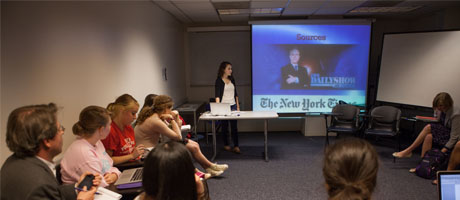From Republican presidential candidate Herman Cain’s alleged extramarital affairs to Congressman Anthony Weiner’s suggestive tweets, sex scandals are a hot commodity in the 24/7 news cycle, often trumping weightier issues of national and international importance. How these lurid new items dominate the public conversation reveals a lot about the impact of mass media and the nation’s collective attitude toward sex and sexuality. This spring, first-year students enrolled in Professor Chad Heap’s Dean’s Seminar “Washington Sex Scandals” were immersed in their own heated debate about how sex scandals reflect and shape changing social, political, and cultural norms and how media coverage and agenda setting affects the public’s interest in each scandal.
“In our class, students quickly realize that no American sex scandal can ever be reduced simply to the ‘facts’ of the scandal at hand,” said Heap, who chairs the American Studies Department. “They learn to look for the underlying significance of each scandal and the ways that the media, political parties, and others use politicians’ sexual indiscretions to achieve their own goals.”
The seminar takes students back to the early nineteenth century and the newspaper publicity surrounding the relationship between Thomas Jefferson and his slave Sally Hemings. Class discussion focuses on the dynamic interaction between the media and American politics and how that relationship has changed over the past two centuries.
“Drawing on their own experiences, students are quick to suggest that the 24-hour news cycle and the proliferation of new media outlets online have contributed significantly to the growing public interest in political sex scandals and their seeming ubiquity in recent years,” said Heap. “But students are invariably surprised to learn how frequently the press reported on, or gossiped about, the sex lives of American politicians in the nineteenth century, usually from a partisan perspective. Over the course of the semester, they have to figure out how to reconcile this discovery with their understanding of the way the media operates today.”
For their final projects, students were asked to examine recent scandals within the framework of media coverage. Bailey Mohr chose to focus on the discrepancy in coverage of two congressmen from New York—Republican Chris Lee and Democrat Anthony Weiner—both of whom resigned in disgrace after posting suggestive photos online.
“Even though the content surrounding the two scandals was similar, the stories received very different amounts of media coverage and scrutiny,” said Mohr. “I discovered that a politician’s response to a scandal directly impacts how that scandal plays out in the media.”
Mohr’s analysis noted that Weiner’s behavior became a major media item that remained in the news cycle for months. In particular, he was mocked by the Daily Show with Jon Stewart primarily because of his denial of guilt over the sexually explicit photos at the center of the scandal. Mohr asserted that because Weiner waited 20 days to admit his guilt, he prolonged the media coverage and gave the press more of a story. In contrast, Lee handled a similar situation very differently. By admitting fault and resigning a few hours after his story broke on the blog Gawker, Lee “did not give the media much to report on,” said Mohr.
Class discussion revolved around morality issues in the context of how politicians handled the news and how new technology affected coverage. For example, established newspapers such as the New York Times portrayed a more conservative view of the events, while the blogs and the Daily Show set a more mocking, sarcastic tone in reporting on the politicians’ behavior.
“Sex scandals always provide some insight into broader transformations in American culture,” said Heap. “But what I really enjoy about teaching this class is the opportunity to learn from my students. As they discover most of these scandals for the first time, they bring new and diverse perspectives to the material that inevitably renews and reshapes my own understanding of the course topic and readings.”


